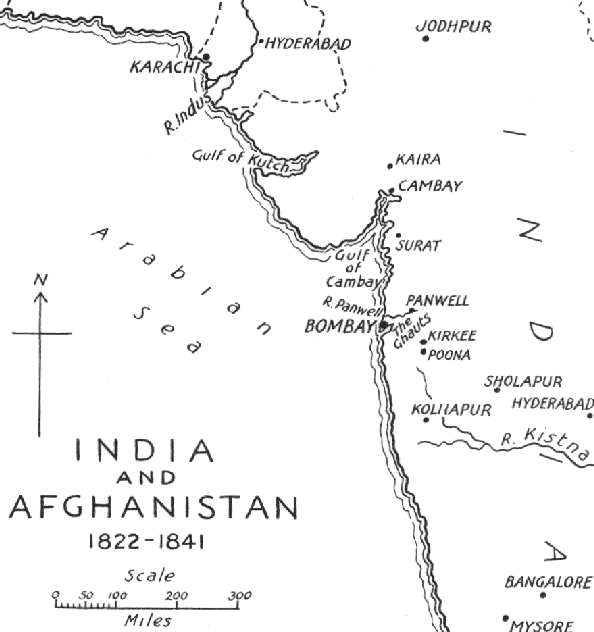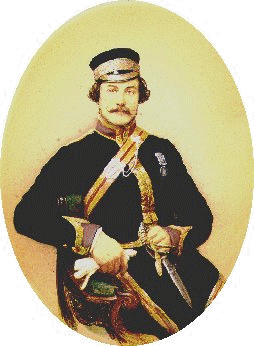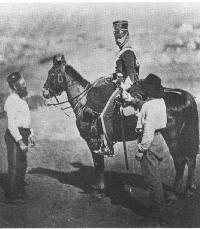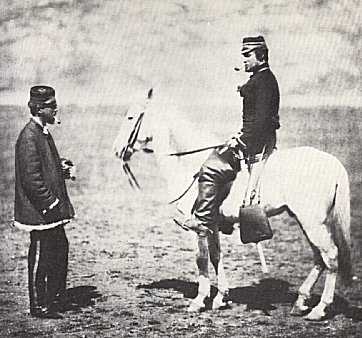The 4th (The Queens Own) Regiment of Light Dragoons.
My interest in this regiment currently only spans the period from 1824-1856 (the known service of my great-great grandfather, George Ellis) and so the information listed here relates mainly to that period - however I do have further details should you wish to contact me.
- Names
- History & Troop Movement
- Battle Honours (1743-1854)
- Colonels of the Regiment, and Lt. Colonels in command (1735-1860)
- Newspaper Cuttings
- Hart's Army List for the regiment (1847-1856)
- Crimean Casualties
- Regimental Records & collections
- Images
- Links
- Bibliography
Names
In tracing the regiment, one has to consider that the name of the regiment
has changed many times throughout its history such that identifying it
can become troublesome ; especially if sources refer to it by a later or
earlier name than the period of history would suggest. In addition,
similarly-named regiments can muddy the waters ! The 4th Dragoon Guards,
for example are a different regiment.
Maybe this is obvious to those who are familiar with regimental names
and history but proved most confusing to me for a while...!
1685 - The Princess Anne of Denmark's Regiment of Dragoons
1706 - 4th Dragoons
1788 - The 4th (Queens Own) Dragoons
1818 - The 4th (Queens Own) Light Dragoons
1861 - 4th (The Queens Own) Hussars
1958 - Queens Royal Irish Hussars (4th Hussars amalgamated with the 8th Kings Royal Irish)
1993 - Queens Royal Hussars (the QRI Hussars amalgamated with
the Queens Own Hussars)
Summary of History & Troop Movement
(Extracted from "Records & Badges of the British Army" by H.M Chichester & G. Burges-short)
The 4th or Queens Own Hussars traces its origin to certain independent troops of dragoons raised respectively at Warminster, Shaftesbury, Shepton-Mallet, Glastonbury, Frome, Wincanton, Ilchester, and Bradford, which, the last excepted, were regimented under Colonel the Hon. John Berkeley on the 17th July 1685 as "The Princess Anne of Denmark's regiment of Dragoons".
(according to "4th Hussar" by David Scott Daniell) ...
1749-1809 : The regiment returned from Flanders and spent the ensuing years alternating between Scotland (1-2 years at a time) and England.(4-5 years at a time). There are no detailed records of service from this time, however there are some reports that pinpoint the regiment. In 1758 they were in Scotland.
1780 : Based at Canterbury, when the "Gordon Riots" broke out in London. The troops were called to London and traveled the 56 miles to London in a single day. The following week of violence saw 285 of the rioters killed by the troops, with the 3rd and 4th Dragoons accounting 101 of them.
1803-1806 : Quartered in Lewes and, Brighton, Sussex. 80 miles away at Boulogne, Emperor Napoleon had an army of 100,000 men waiting to invade England.
1807 : With the threat of invasion over, the regiment marched from its barracks in Lewes, to Chichester where it spent a year, followed by 6 months at Ipswich.
1808-1809 :
In the November, the regiment were now based in Canterbury when it
received orders to prepare to embark for active service in Portugal. Napoleon
had attacked Portugal in the previous December and had taken Lisbon. In April
1808 he had dethrowned the King of Spain. The English army had marched
into Spain to sever French supply lines and join with the Spanish army. The
4th Dragoons were ordered to join this force, and marched to Portsmouth on
December 5th. Although they spent 3 days on board ships with the 3rd
Dragoon Guards, they were ordered to disembark and march to barracks in
Chichester and Arundel. - the expedition had been cancelled following news
that all had not gone well in Spain.
In March 1809, the regiment once again received ordered to march to Portsmouth
and on the 16th April they sailed on the "Venus" for Portugal.
A depot was left behind in Shoreham.
1809-1814 :
The regiment formed part of Wellington's army in the Peninsular Wars. The
following battles were granted as Battle Honours :
Battle of Talavera - 27/28th July 1809.
Battle of Albuera - 16th May 1811.
Battle of Salamanca - 22nd July 1812.
...however they one of the few regiments to have served the entire Campaign
and were also present at the battles of Busaco, Usagre, Vittoria, and
Toulouse.
On the 20/21st July 1814 the regiment finally landed home in Dover.
1814 :
The troops were immediately dispatched to Ireland for a tour of duty - in
those days there was no official leave nor a particular welcome home !
They marched to London where the were inspected at Hounslow Heath. After a
march to Lichfield where the regiment effected a reduction of two troops, they
continued on to Liverpool and landed in Dublin in August.
1815-1819 :
After six months in Dublin, the headquarters moved to Carlow in the
February, with the troops dispersed increasingly over the entire south of the
country. The reason for the dispersal was that Napoleon had escaped from Elba
and his landing in France had required other regiments from Ireland. By the
summer, the 4th Dragoons were the only regiment left in the country.
In November, the headquarters moved to new barracks in Cahir, where they
stayed until 1819, when it moved to Cork.
1819 : The regiment finished a tour of duty in Ireland and moved to the West Country, with headquarter in Exeter and troops in Plymouth, Truro and Taunton - helping the excise men to control the smuggling.
1820 : In the spring they marched to Birmingham with two troops detached at Coventry but a few weeks later they were called to London and were posted to Croydon, Lewisham and adjacent towns.
1821 :
In July, with the coronation of George IV, the regiment moved to Greenwich
and Blackheath. After the coronation, they went to Romford Barracks to
prepare for a tour of duty in India - they were increased in size to nine
troops (each of about 50 men).
On the 31st December at 3.00am, the regiment marched from Romford Barracks
for Tilbury docks, bound for India.

1822 : In May, the regiment arrived in India (Bombay harbour) and traveled 250 miles north to the Bay of Cambay, and then marched 50 miles north to Kaira.
1823-1826 : Due to terrible health conditions with cholera and fever being prevalent, the regiment suffered tremendous losses :-
- 61 died in 1823;
- 83 died in 1824;
- 104 died in 1825 and
- 195 died in 1826!
1827 : In February, the regiment arrived in Kirkee - but the barracks were not complete and so they spent six months under canvas until the building was completed in June. From then on, the health situation improved so that the death rate fell to around 30 men a year - a figure that was considered very good in those days.
1828-1837 : The time in Kirkee passed without much incident, except for 1837 when a fever epidemic struck, and Colonel Fendell ordered the regiment out of the barracks while it was whitewashed, the floors taken up and the cesspits filled in.
1838-1840 : Two squadrons of the regiment joined the army that took part in the 1st Afghan War. They returned after 18 months away and in that time they lost 3 officers and 58 rank and file - all to fever and cholera and none to enemy action.
1841 : The 4th Dragoons ended their tour of duty in India - the 14th Dragoons took over. 150 NCOs and men transferred from the 4th, to join the 14th. The remaining men marched to Bombay and departed in November.
1842 : In March, the regiment arrived at Gravesend from India. They were headquartered in Canterbury and reduced to six troops.
1843 : Three troops were detached from the then HQ in Exeter to march into South Wales to help the authorities riots caused by "Rebecca and her daughters".
1844 : Regiment moved to Ipswich and Norwich.
1845 : The regiment moved to London; at Hounslow and Hampton Court.
1846-1851 : The regiment were posted once more to Ireland and were scattered across the south of the country to deal with the widespread civil unrest. In 1851 (sadly AFTER the time of the census!) they returned to England and were based in Middlesex for 3 months and to Hampton court and Woolwich for 9 months.
1852 : In May they returned to their old barracks in Ipswich and Norwich.
1853 :
The regiment left Ipswich in the summer and moved to Chobham camp for
a month's divisional training with the 2nd Division.
After this, the regiment went to Brighton for 9 months.
1854-1855 :
In May, they marched to Dorchester to join the army being assembled
for the Crimean War. On the 2nd July the order was received and the regiment
was formed into 2 squadrons of two troops each; each with a total of 21
officers and 299 other ranks. On the 12th July the regiment assembled in
Exeter and marched to Plymouth and the troopship 'Simla' on the 19th July.
The movements of the troops are explained in detail in "4th Hussar"
and are not listed here at this time, but it should be noted that the regiment
took part in the battle of Alma in September, the infamous 'Charge of the
Light Brigade' at Balaclava on 25th October, and the ferocious battle of
Inkerman on the 5th November 1854.
1856+
The regiment returned home from the Crimea and enjoyed a 60 year period
of peaceful soldiering.
"Dettingen"
"Talavera"
"Albuhera"
"Salamanca"
"Vittoria"
"Toulouse"
"Peninsula"
"Ghuznee 1839"
"Afghanistan 1838"
"Alma"
"Balaclava"
"Inkerman"
"Sevastopol"
Colonels of the Regiment and Lieutenant-Colonels in command (1735-1861)
Colonels :- |
|
| Sir Robert Rich | 13 May 1735 |
| Lt. Gen. the Hon. Henry Seymour Conway | 3 Feb 1768 |
| Maj. Gen. Benjamin Carpenter | 24 Oct. 1770 |
| Gen. Lord Howard de Walden | 9 March 1788 |
| Gen. Sir Robert Sloper | 1 June 1797 |
| Gen. Guy Lord Dorchester | 14 Aug. 1802 |
| Maj. Gen. Francis Hugonin | 9 Nov. 1808 |
| Lt. Gen. Lord R.E.H. Somerset | 31 March 1836 |
| Lt. Gen. Sir James Dalbiac | 24 Sept. 1842 |
| Lt. Gen. Sir George Scovell | 18 Sept. 1847 |
| Maj. Gen. Sir James Hope Grant | 18 Jan 1861 |
Lt. Colonels in command :- |
|
| John Brown | 8 May 1721 |
| Daniel Leighton | 20 June 1737 |
| Archibald Douglas | 4 February 1747 |
| George Warde | 9 October 1758 |
| Edward Griffith | 17 November 1773 |
| James Hugonin | 22 December 1775 |
| Francis Hugonin | 2 March 1794 |
| Lord R.E.H. Somerset | 3 September 1801 |
| James Dalbiac | 25 November 1808 |
| Nathan Wilson | 21 November 1822 |
| George Sale | 2 June 1825 |
| William Fendall | 24 December 1832 |
| John Scott | 15 November 1833 |
| Francis Daly | 24 June 1842 |
| William Parlby | 30 January 1846 |
| John Vandaleur | 14 August 1846 |
| Lord George Paget | 29 September 1846 |
| Alexander Low | 1 May 1857 |
| George J. Brown | 4 May 1860 |
Regimental Records and Collections.
While many military records are held in the Public Record Office at Kew, the regiment also holds some records and archives at their Home Headquarters in London and can be contacted at :
- Home Headquarters
The Queen's Royal Hussars
Regents Park Barracks
Albany Street
London
NW1 4AL
-
The Redoubt Fortress,
Royal Parade,
Eastbourne,
East Sussex,
BN22 7AQ
This museum is open to the public from Easter - November but is manned throughout the year and so can be reached by telephone.
I have compiled this short collection from a number of sources - I will add more as I get them...
An officer of the 4th Light Dragoons with an orderly and civilian (?) servant
Two officers of the 4th Light Dragoons
Officers of the 4th Light Dragoons - early 1855
4th Light Dragoons Camp.

Capt. Thomas Hutton
(by kind permission of Carol Haselwood & family)
Lives of the Light Brigade (The late E J Boys' site dedicated to the lives of the officers and men of the Light Brigade who fought in the Crimean War 1854-1856.)
Shadows Of Time (includes an excellent collection of 4th Light Dragoons transcriptions relating to India)
Queens Royal Hussars (Site dedicated to current regiment)
4th Hussar : The story of a British Cavalry Regiment - David Scott Daniell
Honour the Light Brigade - Lummis & Wynn
The Reason Why - Cecil Woodham-Smith
Letters from the Crimea - Captain Robert Portal (Available at the British Library)
Life in the ranks - W Taylor
Historical Record of the 4th Light Dragoons (to 1842) - Richard Cannon
Records & Badges of the British Army- H.M Chichester & G. Burges-short
The Crimean War - Andrew Lambert & Stephen Badsey (The War Correspondents Series)
And They Blessed Rebecca; an account of the Welsh toll-gate riots 1839-1844 - Pat Molloy
Page last updated : 19 May 2009



